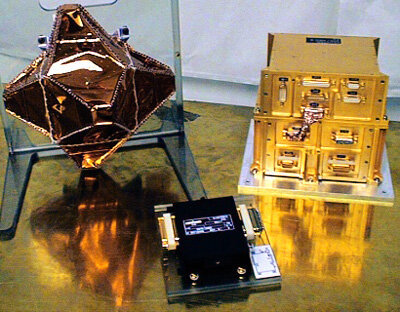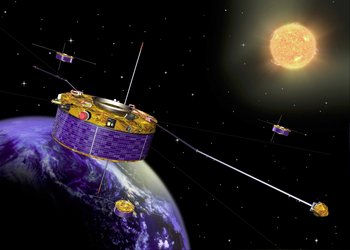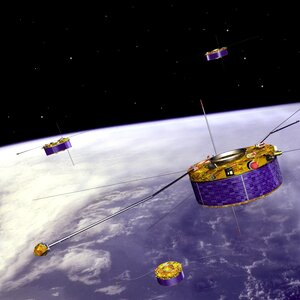Instruments I: Wave Experiment Consortium
Each of Cluster's four spacecraft carries an identical set of 11 instruments to investigate charged particles, electrical and magnetic fields. These were built by European and American instrument teams led by Principal Investigators.
Wave Experiment Consortium (WEC)
Five of the instruments (DWP, EFW, STAFF, WBD, and WHISPER) are designed to measure electric and magnetic fields and waves. They have been grouped together to form the 'Wave Experiment Consortium'.
DWP – Digital Wave Processing experiment

Principal Investigator: Michael Balikhin, UK
The control and computing brain for the WEC. It provides precise timing that allows correlation studies between the four spacecraft, and has a particle correlator that enables variations in the electron population around the spacecraft to be compared with the wave measurements.
EFW – Electric Field and Wave experiment

Principal Investigator: Mats André, Sweden
EFW uses electrical sensors on four 42-metre-long wire booms to measure electric fields and waves. Currents generated in each sensor reveal the density of nearby electrons. EFW can take up to 36 000 measurements per second allowing the motion of plasma structures and wave fronts travelling at thousands of kilometres per second to be detected.
STAFF – Spatio-Temporal Analysis of Field Fluctuation experiment

Principal Investigator: Patrick Canu, France
A magnetometer that picks up any rapid variations in the magnetic field the spacecraft happens to be passing through. This occurs particularly in regions where the charged particles of the solar wind interact with the magnetosphere.
WBD – Wide Band Data instrument

Principal Investigator: Jolene Pickett, USA
WBD is designed to provide high-resolution measurements of both electric and magnetic fields in selected frequency bands. WBD listens for radio whistles and hisses from particles that bounce around near Earth's magnetic poles.
WHISPER – Waves of HIgh frequency and Sounder for Probing of Electron density by Relaxation experiment

Principal Investigator: Pierre Henri, France
WHISPER uses radar to measure the density of charged particles in space. Brief radio pulses, sent out through the two 42-metre-long EFW wire booms, trigger oscillations or 'echoes', which are detected after a short delay. In addition, WHISPER monitors natural wave activity in the frequency range 2–80 kHz.





